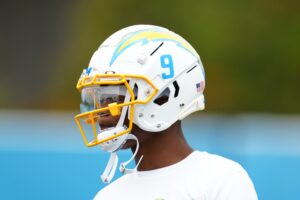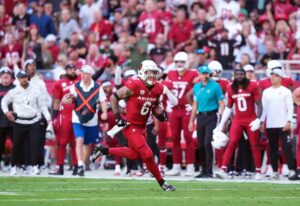The San Francisco 49ers and the New England Patriots shocked the world when they executed a rare midseason blockbuster trade. The 49ers will send their second-round pick to the Patriots in exchange for backup quarterback Jimmy Garoppolo. Before the trade, the 49ers quarterbacks included journeyman Brian Hoyer, and developmental project C.J. Beathard. Hoyer is by no means a quarterback for which any team should build their franchise around. Beathard is promising, but as evident by his recent play, is far from being an NFL starter. This hole at quarterback opened the door for a roster move. It is very uncommon to see a trade with such league-wide magnitude happen during the regular season, and there is a lot to unpack.
The Good, the Bad, and the Strange of the Jimmy Garoppolo Trade
The Good
Upon first glance, the 49ers have a lot to love about this trade. They appear to have landed their quarterback of the future for a relatively cheap price. There were rumors that Kirk Cousins may sign in San Francisco, but he is unlikely to hit free agency. Drafting a top prospect like Josh Rosen or Sam Darnold is intriguing, but they are unproven, and would require the 49ers first round draft pick. Garoppolo only required a second-round pick, and has more experience. The 49ers may have to pay him a higher salary, but with the state of the current 49ers cap space, the limiting resource is draft picks, not salary.
Kyle Shanahan has coveted Garoppolo since he first scouted him. When Shanahan was the offensive coordinator for the Cleveland Browns, he had a high draft grade on Garoppolo. The Browns passed on Garoppolo, who wound up with the Patriots with the 62nd overall pick. With the Patriots, Garoppolo studied under two all-time greats in Tom Brady and Bill Belichick. In limited game experience, Garoppolo has impressed, completing 67% of his passes to go along with five touchdowns and no interceptions.
It is easy to see why Shanahan likes Garoppolo. He possesses a lot of the traits Shanahan wants in his quarterback. Garoppolo is buttoned up off the field, and earned the respect of his teammates. He has a lightning quick and accurate release, and can quickly go through his progressions. He distributes the ball to his skill position players, much like Matt Ryan did in his MVP campaign. Most importantly, he seemed more than capable of running Josh McDaniels’ offense in New England. With Shanahan tailoring an offense to his skill set, Garoppolo could be one of the next great quarterbacks in the NFL.
The Bad
While this trade has plenty of good for the 49ers, there also is some bad. Despite all the glowing reviews, Garoppolo has only started two regular season NFL games. While he was impressive, the 49ers are betting a lot on a very small sample size. If Garoppolo is nothing more than a high-end backup who had a couple good games, then the 49ers are in for a rude awakening when they try to build around him.
Another negative is his injury history. Garoppolo was credited as a draft prospect for being durable. However, in his short stint filling in for the suspended Brady, he sprained the AC joint of his throwing shoulder, and had to miss two games. This injury came in only his second career NFL start. His 6’2” frame is slightly below ideal. Other notable 6’2” quarterbacks include Tony Romo, Aaron Rodgers, and Robert Griffin III, all of which have suffered notable injuries throughout their careers.
There is also a lot of bad history for the 49ers that precedes this trade. Acquiring a backup quarterback in the hopes that they might be a franchise quarterback rarely succeeds. The most recent example was the Houston Texans acquisition of Brock Osweiler. Specifically, acquiring backup quarterbacks from New England has led to little success. Outside of two years of Matt Cassel with the Kansas City Chiefs, no New England offshoot has had any sustained success. While Garoppolo was a much better prospect than any of those quarterbacks, the trend still remains.
The Strange
If the 49ers traded with any other team, it would be easy to call the 49ers the winners. However, trading with the Patriots is a dangerous game. Belichick is one of the greatest football minds of all time, and specializes in the acquisition department. Essentially, the league is playing checkers, and Belichick is playing multi-dimensional chess. There is always a chance he is trying to Jedi mind trick a team into doing a trade that will greatly benefit the Patriots.
On the surface, this trade makes very little sense for the Patriots. Last off-season, Garoppolo’s trade value was at an all-time high, and would’ve returned draft picks that could be used immediately. By waiting half a season, Garoppolo’s value went down, and the Patriots wasted precious time of Brady’s closing window to use the return compensation. It doesn’t make a lot of sense unless Belichick has some ulterior motives.
What is even stranger is Belichick has left the Patriots in a vulnerable situation. While the move is based on the idea of winning now, this move actually hurts the Patriots in the 2017 season. They now do not have a competent backup. Should Brady go down with injury, Garoppolo has proven he could win games, at least in a short stint. Now the Patriots do not have the luxury of a high-end backup. An injury to Brady will end the Patriots Super Bowl aspirations. It is incredibly strange that Belichick would agree to this trade.
Conclusion
The impact of this trade will affect more teams than the two involved. The 49ers were once believed to be taking a quarterback high in the draft. Now they could sell that pick to a quarterback needy team for a king’s ransom. More teams could get involved in the Kirk Cousins sweepstakes, should one take place. It was incredibly shocking that this trade happened. There are many different elements that make this trade intriguing. The 49ers are betting on the good aspects of the trade outweighing the bad aspects. The strange aspects may never be known. Only time will tell if Garoppolo develops into a top quarterback the 49ers are hoping he can be.
Main Image:






